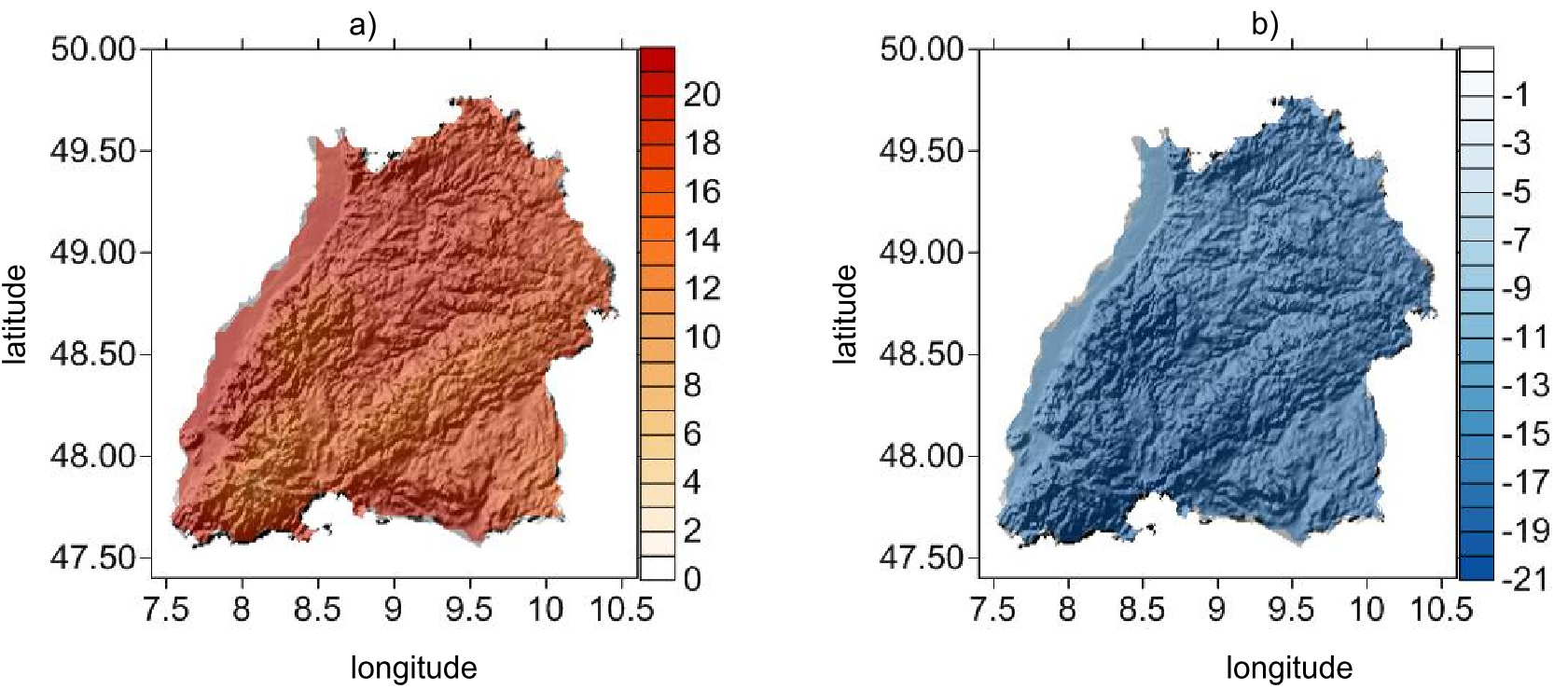KLIMOPASS - Regional Climate Ensemble
- Contact:
Dr. G. Schädler, Dr. K. Sedlmeier
- Project Group:
IMK-TRO
- Funding:
LUBW
Short description
The research program KLIMOPASS(“Klimawandel und modellhafte Anpassung in Baden-Württemberg”, climate change and examplary adaptation in Baden Württemberg), funded by the Ministry of the Environment, Climate Protection and the Energy Sector of the State of Baden-Wuerttemberg, aims to investigate climate change and its impacts as well as the possibilities of adaptation measures. The contribution of IMK-TRO to this project was to provide an ensemble of high-resolution regional climate simulations and to analyze the change of different climate variables and their statistics including ensemble based uncertainty estimates. Our results have been used as input for impact studies of other projects within and outside of KLIMOPASS.
Motivation
Regional measures of adaptation to a changing climate require spatially detailed information concerning the possible changes of climate variables and statistics of practical interest, especially extremes and combinations of extremes. Although the latter, e.g. the occurrence of combined hot and dry or cold and wet extremes, can bear a much higher damage potential than univariate extremes, they have not been studied in much depth up to now. Also, there is an increasing awareness of the importance of assessing the uncertainty of the data. For this purpose, ensemble simulations are a suitable method as has been shown, for example, in the ENSEMBLES project (van der Linden P., and J.F.B. Mitchell (eds.): ENSEMBLES: Climate Change and its Impacts: Summary of research and results from the ENSEMBLES project. Met Office Hadley Centre, FitzRoy Road, Exeter EX1 3PB, UK. 160pp (2009)). However, the resolution of such simulations (~25km) is still too low for regional impact studies. In a previous project by our group (ReSiPrec), it was shown that added value for the statistics of precipitation can be obtained by using the ensemble method in combination with a higher resolution (in this case about 7 km). In the present study this approach is pursued and refined. The ensemble was expanded using different global model driving data, different regional climate model setups and the atmospheric forcing shifting method (Sasse and Schädler, 2013).
Methodology
We performed ensemble simulations (ensemble size 12 members) using the regional climate model COSMO-CLM with a horizontal resolution of 0.0625° (about 7 km) over Germany driven by several global models. The time periods simulated are the recent past (1971-2000) and the near future (2021-2050), as well as transient runs (1971-2050) for selected ensemble members.
Results
Within this project, climate variables (e.g. precipitation, temperature, wind, humidity, solar radiation, cloudiness and water balance components) and their possible future change were analyzed using different statistics such as temporal means, exceedance of thresholds, extremes (e.g. heat or dry periods) and combined extreme events (e.g. simultaneous occurrence of dry days and heavy precipitationheat and drought periods). The ensemble shows a robust increase for mean monthly means of minimum, maximum and mean temperature between the recent past and the near future. In accordance with this, heat related statistics (e.g. hot days, cooling days) increase while cold extremes related statistics (e.g. frost days, ice days or heating days) decrease. This is exemplarily shown in Figure 1 for cooling and heating days.

Figure 1: Near future change of the annual number of cooling days (a) and heating days (b).
Whereas mean values of other variables such as precipitation sums, relative humidity, wind velocity only show a small or non-robust change signal, extreme values of precipitation show a robust increase in the near future, i.e. the variability increases. The frequency of compound hot and dry extreme events also increases in Baden-Wuerttemberg as is shown in Figure 2.

Figure 2: Near future change of the annual number of compound hot and dry days in summer between 1971-2000 and 2021-2050.
An analysis of other compound extreme could be of interest as in some cases the compounding of extreme events greatly enhances their impact.
As an alternative to the standard analysis methods, an analysis of extremes using Markov chains was performed. Details can be found in Sedlmeier et al. below.
Publications:
Sedlmeier, K., Mieruch, S., Schädler, G., Kottmeier, Ch.
Compound extremes in a changing climate - a Markov Chain approach
submitted to Nonlinear Process. Geophys.
